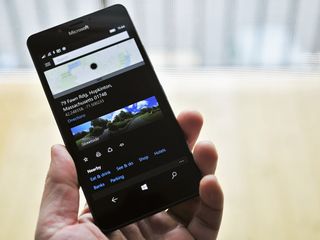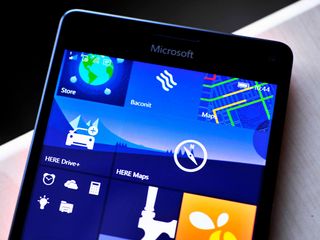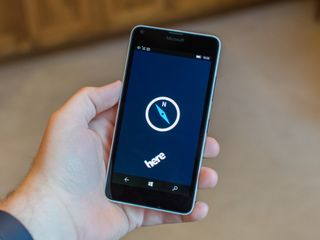Microsoft will continue to use HERE Maps data but many questions remain

This morning HERE dropped some rather big news on the Windows Phone community by announcing that their Windows Phone 7 era apps will no longer work on Windows 10 Mobile devices past June 30, 2016. As a result, they are removing the apps from the Store to prevent confusion after that date.
There is some confusion, however, about what this all means for Windows 10 Mobile users. Here is a quick hit list of things to keep in mind as well as some questions we have about these coming changes.
HERE Maps will not work on Windows 10 Mobile after June 30
In the HERE blog post the company specifically notes that the apps themselves will "no longer work on devices running Windows 10 mobile after June 30, 2016."
That is much more than just we won't be offering the apps anymore as it sounds like the HERE apps will break after this date (give or take). In fact, some users are already reporting the apps not working (or working intermittently) on the Fast Ring Insider builds for Windows 10 Mobile (Redstone releases e.g. build 14283 or higher).
But why June 30?

Good question. In fact, this is the primary issue that none of us currently know the answer to. Is there an API licensing issue that is timed to expire on that date? Did Microsoft and HERE have a contract of support for the apps that is coming to end on June 30? Is there something in Windows 10 Redstone that irrevocably breaks the old app?
Currently, we do not know the reason, but it could be some, none, or all of those listed above.
What about Windows 10 Maps and HERE data?
The real crux of all of this is that Microsoft and HERE are not going their separate ways. Far from it. The HERE Twitter account responded to an inquiry directly about that noting that Microsoft is still a big customer:
Get the Windows Central Newsletter
All the latest news, reviews, and guides for Windows and Xbox diehards.
@deanleigh thanks for appreciating our WP apps; Microsoft will continue to be one of our most important customers ^P@deanleigh thanks for appreciating our WP apps; Microsoft will continue to be one of our most important customers ^P— HERE (@here) August 4, 2015August 4, 2015
This means that Microsoft's native Maps app for Windows 10 and Windows 10 Mobile will still use HERE data just as it does today and this evidently not changing.
What is the goal HERE?

Many fans of HERE Maps – and perhaps more importantly HERE Transit – are wondering why this is happening. Besides the reasons above, it does seem like Microsoft made a decision some time ago to discontinue having two apps for navigation.
In other words, if Microsoft is building their own Maps app that uses – and still uses – HERE data, why have a separate app that basically does the same thing but is old and doesn't leverage Windows 10 and its new APIs? Just put it all into one, kick ass app and call it a day.
Of course, you are likely to quip that Maps for Windows 10 and Mobile is a far cry from what HERE Drive, Maps, and Transit can do for you today. For some users, that is most certainly true. In the U.S., I would argue it is not. Regardless, there will be a hole left for many users who prefer HERE over the Windows 10 Maps app, and that is a legitimate problem.
WinBeta's Zac Bowden dropped a hint that some big changes are coming to Windows 10 Maps real soon. Although we do not know the details of these features, the timing suggests a Build/Redstone/summer release. We are likely to learn more in just about two weeks at Build.
The loss of HERE Maps is nothing to be upset about, I know of a couple awesome improvements coming to the Win10 Maps app soon :)The loss of HERE Maps is nothing to be upset about, I know of a couple awesome improvements coming to the Win10 Maps app soon :)— Zac Bowden (@ZacB_) March 15, 2016March 15, 2016
Microsoft's real plan may be to deprecate the HERE apps right as they ramp up their own Windows 10 Maps offering with the Windows 10 Redstone release. That is speculation at this time, but not far-fetched either. Clearly, Windows 10 Maps is not a finished product as literally nothing about Windows 10 and Mobile is ever "finished".
The big risk here for Microsoft is whether these alleged changes will be enough to offset HERE especially in Europe where the nav company actually has some clout. That part remains to be seen.
One thing seems clear at this time, however. None of this is a surprise to Microsoft or HERE. These changes appear to be all planned long ago. This change does not look like a sudden "business decision" to abandon the platform but rather a deliberate strategy.
Hopefully, by June 30 it will all make much more sense.
As far as HERE the company seems to be angling for more map licensing and in-car ventures rather than consumer app products. While HERE remains - for now - on iOS and Android those platforms benefit from the juggernaut that is Google Maps. It is not obvious that HERE will continue to develop such apps in the face of a such a challenge nor is it clear if consumers even care about the product.

Daniel Rubino is the Editor-in-chief of Windows Central. He is also the head reviewer, podcast co-host, and analyst. He has been covering Microsoft since 2007, when this site was called WMExperts (and later Windows Phone Central). His interests include Windows, laptops, next-gen computing, and watches. He has been reviewing laptops since 2015 and is particularly fond of 2-in-1 convertibles, ARM processors, new form factors, and thin-and-light PCs. Before all this tech stuff, he worked on a Ph.D. in linguistics, watched people sleep (for medical purposes!), and ran the projectors at movie theaters because it was fun.
